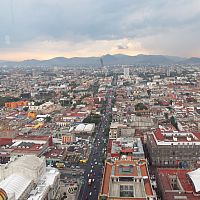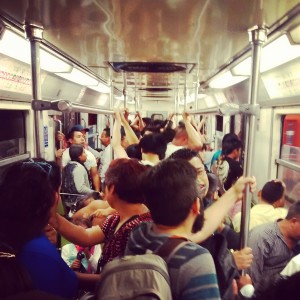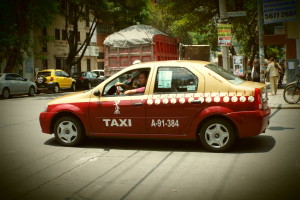 Is Mexico City safe? That’s a question that I get asked a lot.
Is Mexico City safe? That’s a question that I get asked a lot.
It’s understandable. I live in a country plagued by drug violence, corruption, and impunity. According to the Global Peace Initiative 2023 study, Mexico ranks pretty low in their peace index (136th out of the 163 countries, which is however better than when I originally wrote this post in 2016 when they were 140th). Mexico has also risen and fallen among the top 10 most dangerous countries to be a journalist since the early 90s but according to the 2024 Reporters Without Borders index of 180 countries, Mexico is currently the 120th most dangerous for press, so right on the cusp of the bottom third.
But violence in Mexico is also constantly under the media spotlight, particularly in the U.S., with only the bloodiest and most gruesome stories fit to print. This has led to lots of fear-mongering about a country that has so much more to offer than its bad reputation implies.
Despite all the bad press that Mexico has gotten over the years, when the New York Times named Mexico City their #1 place to visit in 2016, they were confirming something that many travelers to Mexico had already come to realize — that the country’s capital is an incredibly vibrant city bursting with culture and history, and is a must-see destination south of the U.S border. Since then Mexico City has become off-the-scales popular with travelers and digital nomads looking for a better life in a cool city.
But there’s still that nagging question… how safe is Mexico City, really? The federal district has long been thought of as an oasis from the violence suffered by other parts of Mexico and since 2020 the city’s homicide rate has been dropping steadily. According to data from the National Institute of Statistics and Geography (INEGI), homicide deaths in CDMX in 2023 were 7 for every 100,000 residents, which is a decrease of more than half from when I first wrote this article in 2016 and it was 14.24 per 100,000 inhabitants. That’s a pretty low number compared to Houston’s of 19 for every 100,000 or according to the Rochester Institute of Technology, Chicago’s 24 for every 100,000, Los Angeles’ 8.8, or the numbers of MANY other major U.S. cities.
If 7 in 100,000 still seems high to you, just think that if the murder rate here is 7/100,000, that means your chances of being killed are about 1 in 14,285. Take into account that you’re a tourist here for a short period of time and your risk level drops even lower. 
Particularly of interest for tourists will be that several sources I found site Delegación Cuauhtemoc (which is the borough where Roma, Condesa, and the Centro Historico are located), apparently has the highest number of criminal cases filed for 2023. Mexico City’s once-mayor, soon-to-be president Claudia Sheinbaum has often claimed to have cut the city’s crime rates in half during her tenure from 2018 to June 2023 when she left to run for president. That statement tracks according to the statistics above, but there is also the question of “uncategorized deaths” like the ones described in this article by Animal Politico.
You should definitely be careful traveling here, but with the same caution you would exercise in Chicago, Philadelphia, or Washington D.C. Mexico’s capital is no Copenhagen, but don’t let the headlines persuade you that CDMX is not worth the trip.
Here are a few tips you might find useful:
— According to this Forbes article, Mexico and the U.S. are neck and neck when it comes to levels of credit card fraud. There are several ways to give yourself additional security when using a card including opting for credit instead of debit so you don’t have to enter a PIN number, keeping an eye on your account for suspicious activity, using a card with a chip instead of a magnetic strip and being wary of any card readers or ATMs that look as though they have been tampered with.
— It goes without saying that you need to be aware of your surroundings at all times, but particularly in crowded places like public transportation during rush hour or a packed club or bar. Pickpocketing is a common occurrence here.
— At night stick to areas of the city that are busy and bustling, with lots of foot traffic and folks on the street. This isn’t that hard to find in Mexico City and you’d actually be surprised at some of the places that feel the most abandoned in the evening like certain parts of the Centro Histórico and Polanco, as well as upscale neighborhoods like Las Lomas de Chapultepec where vendors and foot traffic are scarce.

— You should learn a little bit of Spanish. This will translate into lots of benefits in lots of arenas, but safety-wise even a low level of Spanish comprehension will keep you from getting lost, being overcharged, or getting scammed.
— Try to blend in. You aren’t likely to see Mexico City residents carrying around massive backpacks, sporting Relox watches in local markets or wearing short shorts and flipflops in the middle of December. Be observant of those around you and follow their lead in how to dress and act.

— Women should use the women’s-only cars on the metro. The designated cars are usually the first cars on the train and only during rush hours. There are signs everywhere now denouncing sexual aggression, but it remains an issue. Sickos will try to take advantage on crowded metro cars, especially with unaware female tourists.
— Stay sober. While it’s tempting to go out and get shmammered on your vacation, stay sober enough to have a conversation, ask for directions, and get yourself home with no problems. This is not an all-inclusive Cancun resort, this is a massive metropolis, don’t wear yourself as a hat, and don’t drink in the street — it is illegal and the cops will definitely want to charge you the fine (which according to this article is between anywhere from 60 to 200 dollars).
— Look both ways. In 2023, a little less than a third (140) of the deaths from traffic accidents (472) were pedestrians. Mexico City drivers are notorious for their wild ways, pedestrians aren’t considered much more than a nuisance.
 I know that the common warning given to tourists here is don’t take street cabs, only “sitio” cabs or now Uber. The only issues I’ve had with street cabs are them trying to overcharge me or getting lost among the city’s thousands of streets and neighborhoods. Both things are sufficient reasons to use Uber, but don’t despair if for some reason you can’t. After taking hundreds of street cabs in this city I can say that the overwhelming majority are fine, just agree to a price or make sure their meter is running when you get in the car and ensure they know where you are going. You can always ask a restaurant or hotel employee to call you cab.
I know that the common warning given to tourists here is don’t take street cabs, only “sitio” cabs or now Uber. The only issues I’ve had with street cabs are them trying to overcharge me or getting lost among the city’s thousands of streets and neighborhoods. Both things are sufficient reasons to use Uber, but don’t despair if for some reason you can’t. After taking hundreds of street cabs in this city I can say that the overwhelming majority are fine, just agree to a price or make sure their meter is running when you get in the car and ensure they know where you are going. You can always ask a restaurant or hotel employee to call you cab.
In my almost 13 years living in this city I have been grabbed on the metro twice during a crowded commute, had my phone stolen once out of an open bag, have never had a cab driver go rogue, and never had my car broken into (when I had one). I don’t think I live a particularly tame lifestyle — although I do live in a decidedly middle-class neighborhood — but it’s not flashy either, which helps. I often find myself in areas of the city that I’m unfamiliar with, but do my best to blend in and act like I belong. Rarely will anyone bother you, in fact in most cases you will find Mexicans’ reputation for being overwhelmingly friendly not misplaced.
Chilangos who grew up here tend to feel that the city is much more dangerous than expats I know who have lived here for decades. There are lots of reasons why people perceive their city as unsafe, so take local warnings into consideration but don’t let them dictate your every action. And don’t spend all your time worrying, Mexico City has too much to offer for your fears to get the better of you.
For more tips and suggestions for traveling in the city see: Mexico City on a Budget, the Mini Mexico City Guide, Local Beer on Tap, Monday in Mexico City, and The Best of Breakfast.
Click here to subscribe via RSS
